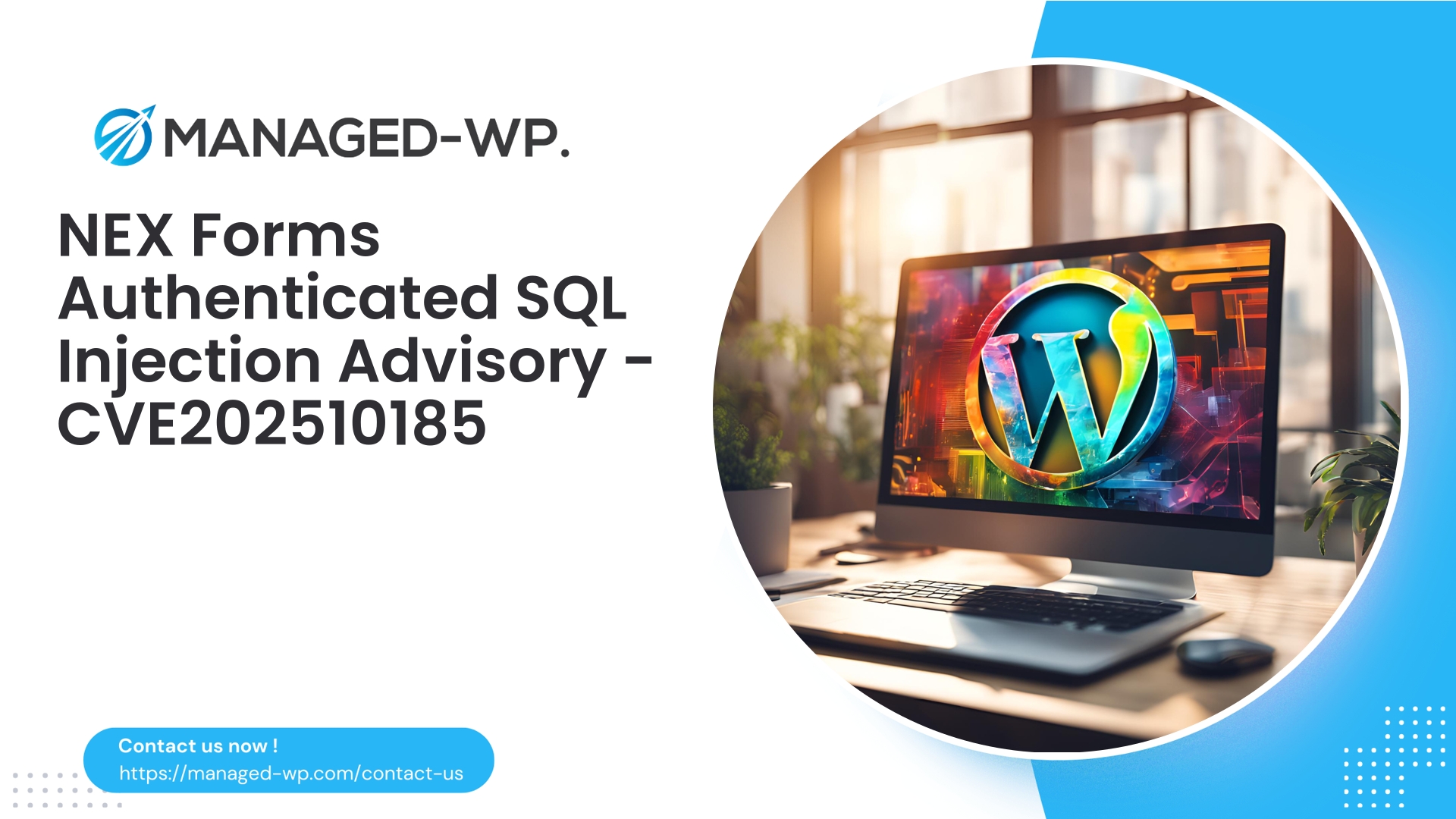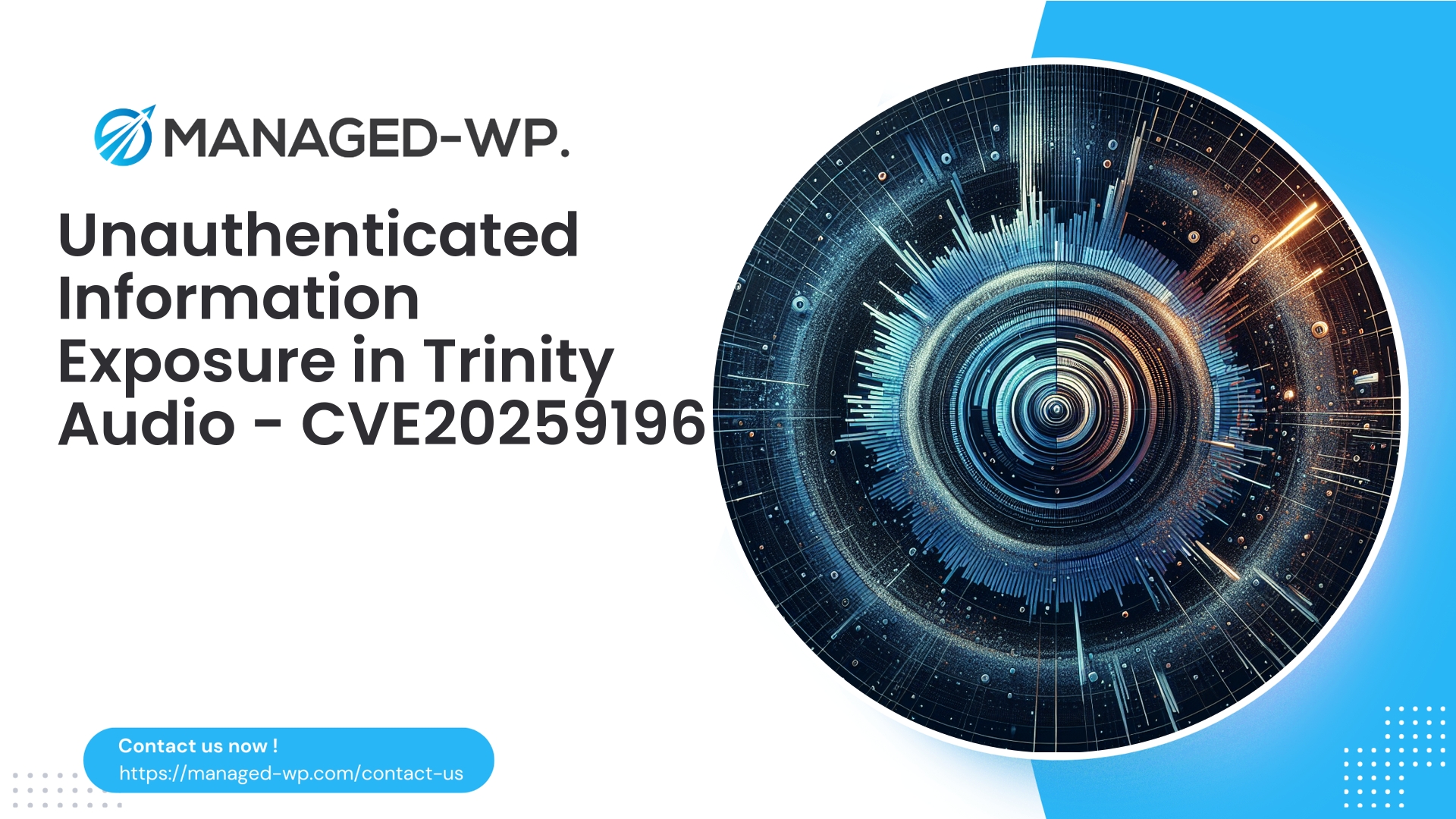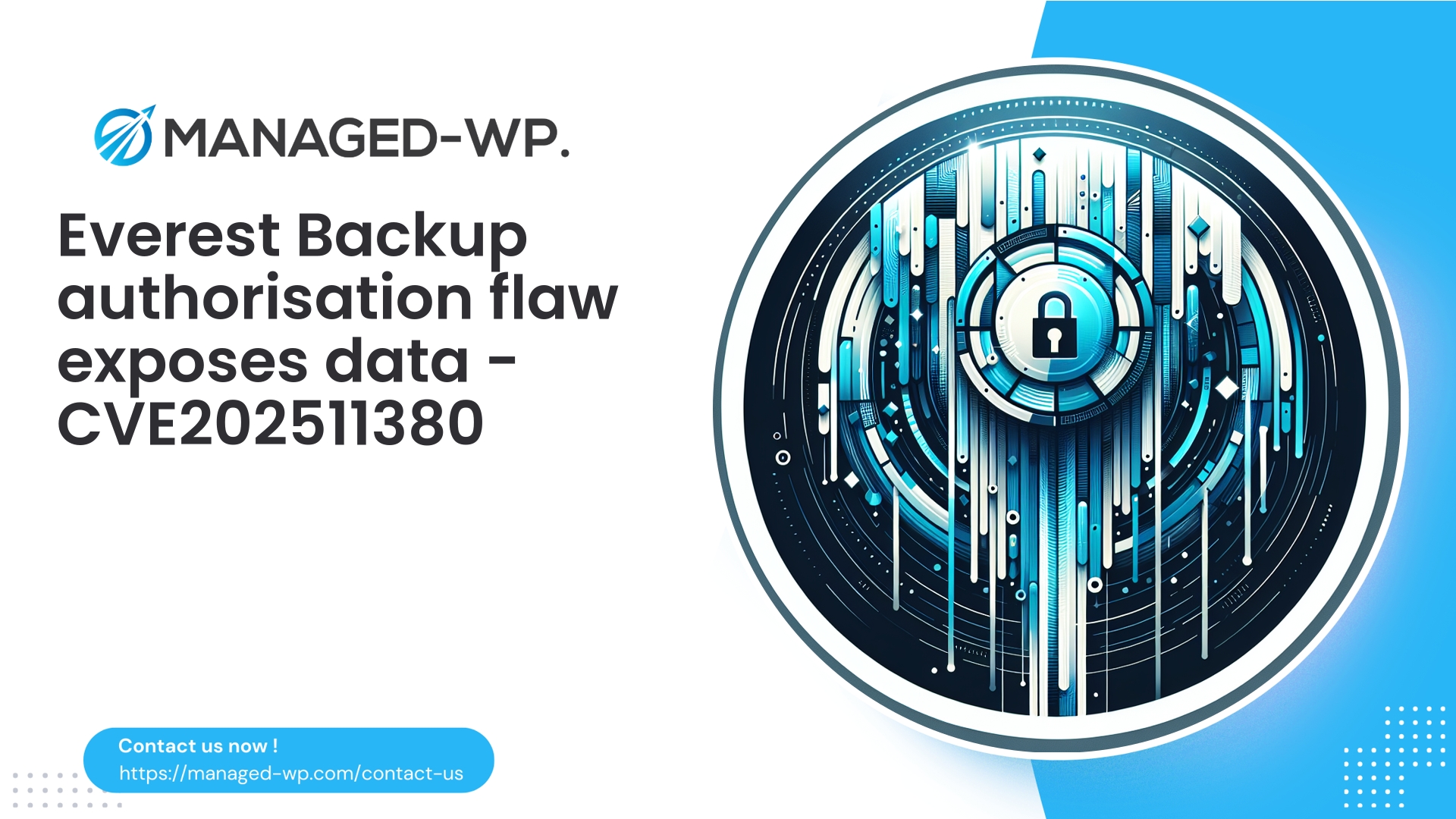| Plugin Name | NEX-Forms |
|---|---|
| Type of Vulnerability | SQL Injection |
| CVE Number | CVE-2025-10185 |
| Urgency | Low |
| CVE Publish Date | 2025-10-10 |
| Source URL | CVE-2025-10185 |
Urgent Advisory: NEX-Forms (<= 9.1.6) Authenticated Admin SQL Injection (CVE-2025-10185) — Critical Actions for WordPress Site Owners
On October 10, 2025, a significant SQL injection vulnerability was publicly disclosed affecting the NEX-Forms WordPress plugin (versions up to and including 9.1.6), tracked as CVE-2025-10185. This flaw allows authenticated administrators to execute arbitrary SQL commands, posing a severe threat to any WordPress site utilizing this plugin. The issue has been addressed in version 9.1.7.
Although exploitation requires administrator access, the impact is far-reaching — including potential data theft, data corruption, or full site compromise. As experienced US-based cybersecurity experts, Managed-WP provides a thorough breakdown of this vulnerability, its risks, and immediate remediation and mitigation guidance to secure your WordPress assets.
Executive Summary (Quick Overview)
- Plugin: NEX-Forms (Ultimate Forms Plugin for WordPress)
- Affected Versions: ≤ 9.1.6
- Fixed Version: 9.1.7
- Vulnerability Type: Authenticated Administrator SQL Injection
- CVE ID: CVE-2025-10185
- Reported By: Security researcher “dutafi”
- Published Date: October 10, 2025
- CVSS Score: 7.6 (High Severity)
- Immediate Risk: Attackers with admin credentials can exploit SQL injection to manipulate or steal sensitive database information, escalate privileges, or deploy persistent backdoors.
Note: If you run NEX-Forms and cannot update immediately, please follow the immediate mitigations detailed below to reduce risk.
Why Is This Vulnerability Critical Even Though It Requires Administrator Access?
It’s a common misconception that an admin-only vulnerability is low-risk because administrators are trusted. However, in the modern threat landscape, this assumption is dangerously optimistic. Consider these factors:
- Administrator account compromise: Credential theft via phishing, brute force, or password reuse is frequent.
- Malicious insiders: Contractors or third parties with admin rights may act maliciously.
- Temporary elevated access: Automated systems or vendor access with admin privileges present attack vectors.
- Post-compromise escalation: Attackers gaining lower-tier access might escalate privileges to admin and then leverage this vulnerability for full control.
Given these realities, any authenticated admin SQL injection vulnerability requires immediate attention.
Understanding Authenticated Administrator SQL Injection
SQL Injection (SQLi) involves injecting malicious SQL code into queries due to improper input handling. In this case:
- Authenticated: The attacker needs to be logged in with WordPress credentials.
- Administrator Role Required: The attacker must have administrator capability.
- Impact: The attacker can execute arbitrary SQL queries against your database to steal, modify, or destroy data.
This vulnerability is particularly dangerous because it operates within the elevated permissions context of an administrator, making it possible to perform a broad range of destructive or stealthy operations.
Potential Impact of Exploitation
A successful attack could result in:
- Exfiltration of sensitive user data: Including emails, hashed passwords, and user meta.
- Creation or modification of administrator accounts: Enabling persistent backdoor access.
- Unauthorized modification of site content, options, and configurations: Including insertion of malicious code or backdoors.
- Corruption or deletion of your WordPress database data and tables.
- Pivoting to other systems: By accessing API keys or secrets stored within the database.
- Covering tracks: Altering logs or timestamps stored in your database.
Because this plugin manages form data, attackers could also target submission data flows, compromising data confidentiality in real-time.
Known Details About CVE-2025-10185
- CVE ID: CVE-2025-10185
- Affected Plugin: NEX-Forms
- Vulnerable Versions: Any version ≤ 9.1.6
- Remediation: Upgrade to 9.1.7 or later
- Privilege Required: Administrator
- Disclosure Date: October 10, 2025
- Researcher: dutafi
For responsible disclosure reasons, this advisory avoids publishing detailed exploit instructions but focuses on mitigation.
Immediate Actions You Must Take
If your site uses NEX-Forms and has administrator management capabilities, take the following steps without delay:
- Update the Plugin: Upgrade to version 9.1.7 or later — this is the most reliable fix.
-
Can’t update immediately?
- Deactivate NEX-Forms to prevent exposure.
- Restrict access to WordPress admin sections via IP allowlisting.
- Enforce multi-factor authentication (MFA) for all administrators.
- Rotate all admin passwords and review active user sessions.
- Audit and remove redundant or suspicious administrator accounts.
- Implement Virtual Patching: Use a Web Application Firewall (WAF) to block known exploit patterns targeting NEX-Forms admin endpoints and suspicious SQL inputs.
- Audit for Signs of Attack: Monitor your logs and database for indicators of suspicious user creation, role changes, unauthorized option modifications, or new PHP files.
- If You Suspect Compromise: Take the site offline, isolate the environment, restore from clean backups, rotate credentials, scan for malware/webshells, and engage with incident response professionals if needed.
If you need assistance, consult with your hosting provider or Managed-WP’s expert security team.
How to Detect If Your Site Has Been Exploited
Be vigilant for these red flags:
- New or unauthorized administrator accounts.
- Unexpected modifications to plugin or form settings, or site options.
- Relevant SQL errors or tracebacks logged during administrative actions.
- Unusual data exports or large-scale SELECT queries.
- Suspicious PHP files that could be webshells.
- Unexplained outbound connections from your server.
- Unexpected database entries or table modifications.
Use logs from WordPress activity monitoring plugins, your web server, database logs (if enabled), and file system integrity checks to identify suspicious activity.
Early detection and swift action are critical to minimize damage.
Recommended Longer-Term Hardening Measures
- Enforce Least Privilege: Minimize administrator accounts to only trusted personnel and use granular roles where possible.
- Adopt MFA: Require multi-factor authentication for all admin accounts.
- Implement Regular Update Policies: Apply security patches promptly and ideally test updates in staging environments before production.
- Maintain Plugin and Theme Inventory: Remove abandoned or infrequently used plugins to reduce attack surface.
- Backup and Restore: Take regular off-site backups and verify restoration procedures.
- File Integrity Monitoring: Monitor core, plugin, and theme files for unauthorized modifications.
- Protect wp-admin Access: Use IP restriction, rate limiting, CAPTCHA, and other controls to secure admin login and management pages.
- Deploy a Web Application Firewall: Use virtual patching to block emerging attack vectors and stop known exploits.
- Secure Development Practices: Ensure all plugin and theme code uses parameterized queries, thorough input validation, and verifies user capabilities and nonces.
- Perform Ongoing Security Scanning: Conduct regular penetration tests and vulnerability scans.
Guidance for WordPress Developers
To prevent SQL injection vulnerabilities like this one, developers must rigorously:
- Use
$wpdb->prepare()or WordPress query APIs instead of interpolating raw variables. - Sanitize and validate all input according to expected types and lengths.
- Never trust client-side or AJAX inputs without server-side validation.
- Always check user capabilities with
current_user_can()and verify action nonces. - Avoid queries that accept raw SQL conditions or ordering parameters directly from user inputs.
- Limit database user privileges to only what is necessary.
- Implement logging and throttle sensitive admin actions.
Adherence to these standards greatly reduces risk of SQL injection.
How Managed-WP Helps Protect Your Site
Managed-WP actively assists site owners in mitigating threats like this vulnerability by offering:
- Virtual Patching: Immediate WAF rules that detect and block exploit attempts targeting NEX-Forms admin sections and suspicious SQL payloads.
- Admin Access Controls: Rate limiting, IP reputation checks, and geo-blocking to harden wp-admin endpoints.
- Behavioral Detection: Monitoring of anomalous administrative activity and data exfiltration attempts.
- Malware & File Integrity Scanning: Automatic detection of backdoors, webshells, and unauthorized file changes.
- Security Alerts and Recommendations: Proactive notifications with step-by-step remediation guidance.
Managed-WP customers with protection services enabled automatically receive virtual patching for such vulnerabilities, buying critical time for patching.
Recommended WAF Strategy for Operators
An effective Web Application Firewall (WAF) deployment for this vulnerability includes:
- Restricting access to vulnerable admin endpoints where possible.
- Blocking requests containing suspicious SQL syntax or payload patterns targeting the plugin.
- Identifying and blocking anomalous admin activity and abuse attempts via rate limiting and behavioral analysis.
WAF rules should be carefully tested to avoid blocking legitimate admin operations that may contain quotes or special characters. Customize rules to match your environment.
Incident Response Checklist for Suspected Exploitation
- Take the site offline or enable maintenance mode.
- Create snapshots of site files and database for forensic investigation.
- Rotate all administrator passwords and revoke sessions.
- Scan the file system for unknown PHP files or webshell signatures.
- Analyze database for unusual user entries, option changes, or unexpected tables.
- Restore clean backups from a known good state.
- Reinstall WordPress core and all plugins/themes from verified sources.
- Run comprehensive malware scans post-restoration.
- Gradually re-enable site services while monitoring.
- Document the incident and apply lessons learned to patch management and security policies.
If unsure about incident handling, engage a professional cybersecurity response team to avoid incomplete remediation.
Communicating to Clients and Non-Technical Stakeholders
- Present facts clearly: “A plugin vulnerability was identified that could be exploited by someone with administrative access. We’re implementing updates and protections immediately.”
- Outline actions underway: plugin upgrade, enforced multi-factor authentication, password resets, and firewall protections.
- Reassure ongoing monitoring and compliance with data protection obligations in case of data exposure.
- Provide expected timelines for remediation and follow-up monitoring.
Clear communication helps build trust and reduces confusion or panic.
Copy/Paste Friendly Practical Hardening Checklist
- Update NEX-Forms plugin to version 9.1.7 or later.
- If update not immediately possible, deactivate NEX-Forms.
- Mandate multi-factor authentication for all admin accounts.
- Rotate all administrator passwords.
- Audit and remove unnecessary admin users.
- Restrict wp-admin access via IP allowlisting where feasible.
- Deploy a WAF with virtual patching for NEX-Forms SQL injection vectors.
- Perform full malware and file integrity scans on your site.
- Review logs for abnormal admin behavior and database queries.
- Maintain tested offsite backups.
- Monitor for unusual or large database exports or queries.
Guidance for Hosting Providers and Site Managers
- Identify customer sites with vulnerable NEX-Forms versions and notify site owners promptly.
- Offer guidance and temporary mitigations including IP restrictions and site-level WAF protections.
- Provide managed patching or virtual patching services for customers unable to update immediately.
- Monitor for mass exploitation attempts by analyzing user agents, request patterns, and targeting of NEX-Forms admin endpoints.
Developer Takeaway: Secure Use of $wpdb and Input Handling
For developers building or maintaining plugins and themes:
- Always use
$wpdb->prepare()when constructing SQL queries involving user input. - Prefer WordPress native APIs like
WP_QueryandWP_User_Queryover raw SQL. - Whitelist and sanitize user inputs consistently.
- Check user capabilities rigorously before executing privileged actions.
- Use nonces to protect against CSRF attacks.
- Implement logging and rate limiting on sensitive admin actions.
Neglecting any of these aspects may expose your code to severe security flaws, especially when running within admin context.
Get Immediate Protection — Try Managed-WP’s Free Security Plan
Managed-WP offers an essential security layer compatible with your existing WordPress setup. Our Basic (Free) plan provides managed firewall protection, unlimited bandwidth, a Web Application Firewall (WAF), malware scanning, and OWASP Top 10 mitigation capabilities. These features help block exploit attempts while you apply necessary patches.
For advanced protections including automated malware cleanup, virtual patching, and managed security, we recommend our Standard or Pro plans.
Sign up today and fortify your site in minutes: https://my.wp-firewall.com/buy/wp-firewall-free-plan/
Why Prompt Patching Is Non-Negotiable
- Security patches immediately close critical vulnerabilities that attackers can widely exploit.
- Once disclosed, automated exploits rapidly propagate — attackers do not discriminate based on site size.
- While WAFs and virtual patches offer valuable stopgap defenses, they must never replace timely updates.
- Patching reduces attack surface and prevents attackers from moving laterally or establishing persistence.
- Sites delaying updates become prime targets for opportunistic attackers.
Final Thoughts from the Managed-WP Security Team
This incident demonstrates two core truths about securing WordPress:
- Every plugin adds attack surface—maintain strict visibility and control over all installed components.
- Security requires defense-in-depth: combine timely patching, secure development practices, robust identity management, strong backups, and network-level protections.
If you manage multiple sites or provide managed services, automate vulnerability detection and remediation workflows wherever possible. Use multi-factor authentication and enforce strict administrator account hygiene to reduce risk dramatically. When urgent vulnerabilities like CVE-2025-10185 arise, respond swiftly — patch first, isolate compromised systems, and leverage WAFs for interim protection.
To start protecting your assets now, sign up for Managed-WP’s Basic (Free) plan for immediate firewall and malware scan activation: https://my.wp-firewall.com/buy/wp-firewall-free-plan/
If you require expert assistance in vulnerability assessment, virtual patching deployment, or incident response following a suspected breach, the Managed-WP security engineering team stands ready to support you.



















